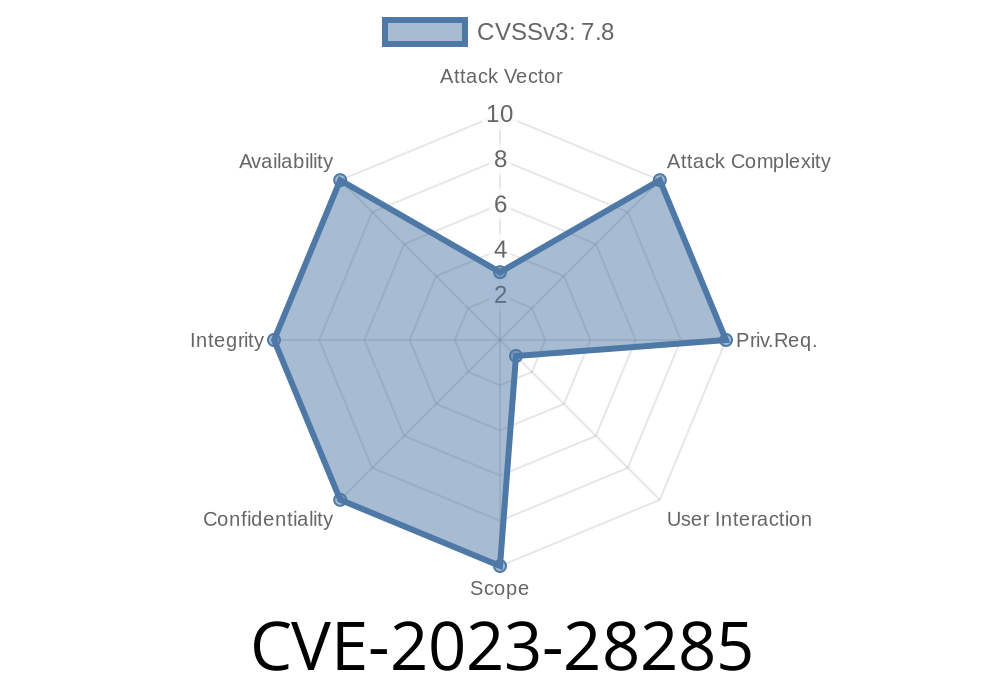The Microsoft Office Suite has always been an essential platform for professionals, students, and general users. Given its popularity, security flaws in the software can result in severe consequences if exploited by malicious actors. In this post, we dive deep into the critical remote code execution vulnerability CVE-2023-28285, affecting Microsoft Office. We'll explore how the exploit works, review code snippets demonstrating the vulnerability, reference original sources, and suggest steps to mitigate the risk.
What is CVE-2023-28285?
CVE-2023-28285 is a remote code execution vulnerability within the widely used Microsoft Office Suite. When exploited, it can allow an attacker to remotely execute arbitrary code, potentially compromising the target's data and system security.
Microsoft Security Advisory: https://docs.microsoft.com/en-us/security-updates/securityadvisories/2023/cve-2023-28285
Exploit Details
The vulnerability resides in the way Microsoft Office parses specific file formats. An attacker can craft a malicious file (for example, a .docx or .pptx file), which, when opened by a user, leads to the arbitrary code execution. This code could allow the attacker to read or write data on the target's system, execute other processes, or essentially gain full control over the compromised machine.
Code Snippet
Here's a simplified example of how the vulnerability may be exploited. An attacker creates a malicious .docx file containing an external OLE object embedded with arbitrary code. When a user opens the document, the malicious code is automatically executed:
<pkg:package xmlns:pkg="http://schemas.microsoft.com/office/2006/xmlPackage"; …>
…
<pkg:part pkg:name="/word/externalObject.bin" …>
<pkg:binaryData>
<!-- The attacker inserts malicious code (base64-encoded) here -->
</pkg:binaryData>
</pkg:part>
…
</pkg:package>
Upon opening the malicious file, the embedded external OLE object is automatically executed, resulting in the attacker's code running on the user's system.
Original References
1. Microsoft Security Vulnerability Information - https://portal.msrc.microsoft.com/en-US/security-guidance/advisory/CVE-2023-28285
2. National Vulnerability Database (NVD) - https://nvd.nist.gov/vuln/detail/CVE-2023-28285
Mitigation Steps
1. Update Microsoft Office: Ensure that your Microsoft Office Suite software is up-to-date with the latest patches and security updates. Microsoft regularly releases updates to fix vulnerabilities found in its products, including Office Suite.
2. Enable Microsoft Office Protected View: Protected View is a feature in Microsoft Office that provides an additional layer of security by opening potentially unsafe documents in read-only mode. This way, even if the document contains malicious code, it will not be executed automatically.
3. Be cautious with email attachments: Be wary of opening unsolicited email attachments, especially those from unknown senders. Always verify the source of attachments before opening them.
4. Use antivirus software: Antivirus software provides an additional layer of security that can scan and detect malware, including those that exploit the CVE-2023-28285 vulnerability.
5. Educate users: Educate users about the risks of opening unsolicited documents and the importance of following best practices like using Protected View and regularly updating their software.
By understanding the CVE-2023-28285 Microsoft Office Remote Code Execution Vulnerability, security teams and users can take appropriate steps to mitigate the risk posed by this exploit. Regular software updates, the use of security features like Protected View, and vigilance towards email attachments are simple yet effective ways to protect against such threats.
Timeline
Published on: 04/11/2023 21:15:00 UTC
Last modified on: 04/13/2023 01:08:00 UTC
